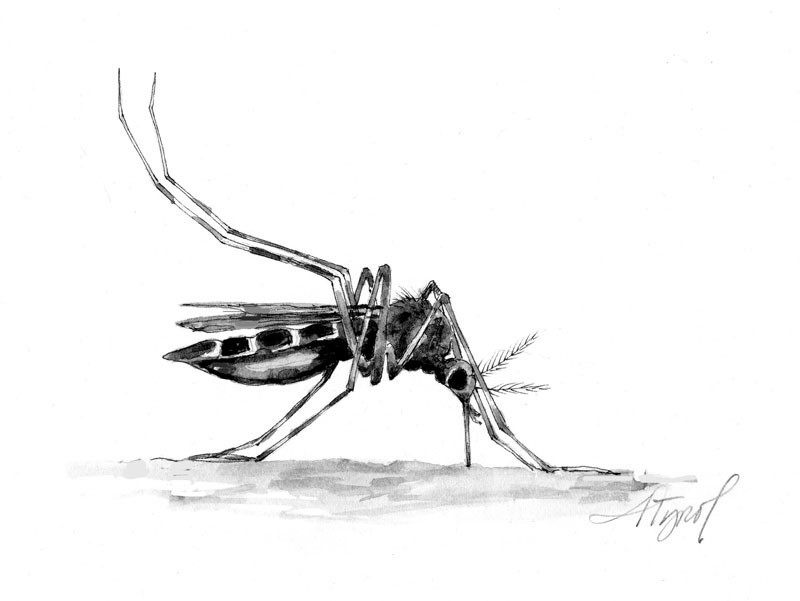
Chances are good you have malaria in your yard. It’s found throughout New England, but you won’t come down with it. This is avian malaria, and, unfortunately for birds, it is as common as the cold virus. They may not show symptoms, but many of your neighborhood birds probably carry the disease.
“Most of the birds I have examined at my backyard feeder are infected by malaria parasites,” says Ellen Martinsen, a graduate student at the University of Vermont who has been studying avian malaria in wild birds for several years.
Malaria is a general term for infections by several species of microscopic parasites called protozoans. Each parasite species infects a particular host. Some only infect humans, while others only infect other mammals, birds or even lizards. And lucky for us, host specialization protects us from contracting avian malaria.
All malaria parasites have similar life cycles. Each has a primary host, such as a bird, and an insect that transmits the parasite, like the mosquito or infamous northern New England black fly. When an infected blood-sucking insect bites a bird, it transfers the parasite to that bird in its saliva. The parasites travel to internal tissues such as liver, spleen, bone marrow and brain cells, and the parasites begin to multiply. They then move into the bird’s red blood cells, where they are positioned to be taken up by another biting insect. If the parasite load is sufficiently high, the bird has fewer uninfected red blood cells, which are critical for moving oxygen throughout the body. The loss of too many cells can lead to progressive weakness and even death.
Birds in New England have lived with malaria parasites for many millennia. There has been plenty of time for natural selection to favor both birds with resistance and parasites that can overcome this resistance. It is a bit like an arms race, and presently it’s a stalemate. Malaria appears to cause little harm to most infected birds. Yet, it is prevalent. Martinsen has sampled nearly 2,500 birds from 110 species throughout Vermont; just over 40 percent were infected.
Martinsen captures birds in fine nets and, using an exceedingly small needle, carefully collects a drop of blood from a vein in the bird’s wing before releasing the bird. The traditional procedure for identifying parasites has been to smear the blood across a glass microscope slide. Back in the lab the slides are dipped in a special stain. Each infected blood cell has a blue stained parasite that is readily visible under a microscope. The parasites have characteristic sizes and shapes that help biologists determine the species infecting the bird.
But biologists are now learning that the traditional identification methods are not completely accurate. ”Their morphology can be misleading and does not offer many characters for species identification,” says Martinsen. “Often the parasite is distorted (from the glass slide), so it is a bit like identifying mammals based on flattened road kill.”
Biologists are now using genetic techniques to identify the parasites. By looking at the DNA of malaria parasites, they are getting a clearer picture of the presence and diversity of malaria parasites and their distribution across both hosts and geography. “I have found many new species of malaria parasites (with the DNA method), because so many distinct parasite (species) are masked by their appearance,” says Martinsen. Biologists don’t have to travel to exotic places to find new species. As Martinsen’s work progresses, she will be revealing a whole new suite of parasite species right here in our backyards.
Martinsen recently teamed up with me and Chris Rimmer, another biologist at the Vermont Center for Ecostudies (VCE), a non-profit wildlife research group based in Norwich, Vt., to examine the prevalence of malaria parasites in songbirds on New England mountaintops. The highest levels of mercury deposition in New England occur on these mountains. Intensive air and precipitation monitoring has led scientists to conclude that most of the mercury originates from coal-fired power plants. Mercury might decrease immunocompetence, causing malaria infection to be much worse.
Our recent studies at VCE have shown that mercury has found its way up the food chain into bird species that inhabit the mountains of New Hampshire and Vermont. Every bird examined, from Bicknell’s thrush to sharp-shinned hawk, had at least some mercury in its blood, but most birds have relatively low levels—that are not known to directly affect bird health or survival.
But VCE is now examining correlations between malaria infections, mercury burdens and body condition of breeding songbirds. Birds may be able to overcome low-level mercury contamination or exposure to malaria, but combine these two stressors with others, such as West Nile virus, climate change, or habitat modifications, and it may spell trouble for bird populations.

